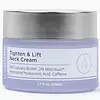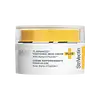What's inside
What's inside
 Key Ingredients
Key Ingredients

 Benefits
Benefits

 Concerns
Concerns

 Ingredients Side-by-side
Ingredients Side-by-side

Water
Skin ConditioningAloe Barbadensis Leaf Juice
Skin ConditioningDiisooctyl Succinate
EmollientTheobroma Grandiflorum Seed Butter
Skin ConditioningDiisopropyl Dimer Dilinoleate
EmollientPropanediol
SolventLimnanthes Alba Seed Oil
Skin ConditioningHydrogenated Ethylhexyl Olivate
EmollientHydrogenated Olive Oil Unsaponifiables
EmollientCaprylic/Capric Triglyceride
MaskingSimmondsia Chinensis Seed Oil
EmollientCetearyl Olivate
Sorbitan Olivate
EmulsifyingCetearyl Alcohol
EmollientCetyl Palmitate
EmollientSorbitan Palmitate
EmulsifyingSorbitan Oleate
EmulsifyingHydrolyzed Hyaluronic Acid
HumectantPiperonyl Glucoside
Skin ProtectingGlycerin
HumectantLecithin
EmollientCaffeine
Skin ConditioningPalmitoyl Carnitine
Skin ConditioningHydrolyzed Plukenetia Volubilis Seed Extract
Emulsion StabilisingGeranium Maculatum Extract
TonicEquisetum Arvense Extract
AstringentHamamelis Virginiana Bark/Leaf/Twig Extract
Skin ConditioningTaraxacum Officinale Extract
Skin ConditioningPropolis Extract
Skin ConditioningCamellia Sinensis Leaf Extract
AntimicrobialCentella Asiatica Extract
CleansingOryza Sativa Bran Extract
Skin ConditioningRosmarinus Officinalis Leaf Extract
AntimicrobialHelianthus Annuus Seed Extract
Skin ConditioningTocopherol
AntioxidantSimmondsia Chinensis Seed Extract
AbrasiveTamarindus Indica Seed Polysaccharide
Skin ConditioningLavandula Angustifolia Oil
MaskingCitric Acid
BufferingSclerotium Gum
Emulsion StabilisingPotassium Sorbate
PreservativeSodium Benzoate
Masking1,2-Hexanediol
Skin ConditioningCaprylyl Glycol
EmollientLonicera Caprifolium Flower Extract
PerfumingLonicera Japonica Flower Extract
Skin ConditioningWater, Aloe Barbadensis Leaf Juice, Diisooctyl Succinate, Theobroma Grandiflorum Seed Butter, Diisopropyl Dimer Dilinoleate, Propanediol, Limnanthes Alba Seed Oil, Hydrogenated Ethylhexyl Olivate, Hydrogenated Olive Oil Unsaponifiables, Caprylic/Capric Triglyceride, Simmondsia Chinensis Seed Oil, Cetearyl Olivate, Sorbitan Olivate, Cetearyl Alcohol, Cetyl Palmitate, Sorbitan Palmitate, Sorbitan Oleate, Hydrolyzed Hyaluronic Acid, Piperonyl Glucoside, Glycerin, Lecithin, Caffeine, Palmitoyl Carnitine, Hydrolyzed Plukenetia Volubilis Seed Extract, Geranium Maculatum Extract, Equisetum Arvense Extract, Hamamelis Virginiana Bark/Leaf/Twig Extract, Taraxacum Officinale Extract, Propolis Extract, Camellia Sinensis Leaf Extract, Centella Asiatica Extract, Oryza Sativa Bran Extract, Rosmarinus Officinalis Leaf Extract, Helianthus Annuus Seed Extract, Tocopherol, Simmondsia Chinensis Seed Extract, Tamarindus Indica Seed Polysaccharide, Lavandula Angustifolia Oil, Citric Acid, Sclerotium Gum, Potassium Sorbate, Sodium Benzoate, 1,2-Hexanediol, Caprylyl Glycol, Lonicera Caprifolium Flower Extract, Lonicera Japonica Flower Extract
Water
Skin ConditioningButyrospermum Parkii Butter
Skin ConditioningGlycerin
HumectantBis-Stearyl Dimethicone
EmollientMyristyl Nicotinate
Skin ConditioningTrimethylolpropane Tricaprylate/Tricaprate
EmollientCetearyl Alcohol
EmollientIsononyl Isononanoate
EmollientBehenyl Alcohol
EmollientPropanediol
SolventCaprylic/Capric Triglyceride
MaskingGlyceryl Stearate
EmollientOryza Sativa Bran Extract
Skin ConditioningHelianthus Annuus Extract
EmollientAdenosine
Skin ConditioningArctostaphylos Uva Ursi Leaf Extract
Skin ConditioningOryza Sativa Extract
AbsorbentRosmarinus Officinalis Leaf Extract
AntimicrobialNannochloropsis Oculata Extract
HumectantAcmella Oleracea Extract
Skin ProtectingOryza Sativa Germ Extract
EmollientAcetyl Dipeptide-1 Cetyl Ester
Skin ConditioningGlycine Soja Oil
EmollientPentapeptide-76 Amide
Butylene Glycol
HumectantAcrylates/C10-30 Alkyl Acrylate Crosspolymer
Emulsion StabilisingPolyglyceryl-3 Diisostearate
EmulsifyingSodium Acrylate/Sodium Acryloyldimethyl Taurate Copolymer
Emulsion StabilisingCeteareth-20
CleansingSorghum Bicolor Stalk Juice
Skin ConditioningSclareolide
MaskingPentylene Glycol
Skin ConditioningTrisodium Ethylenediamine Disuccinate
Polyisobutene
Sodium Polystyrene Sulfonate
Emulsion StabilisingHydrated Silica
AbrasiveEthylhexyl Isononanoate
Emollient1,2-Hexanediol
Skin ConditioningPullulan
Caprylhydroxamic Acid
Beta-Glucan
Skin ConditioningCaprylyl Glycol
EmollientSorbitan Oleate
EmulsifyingHydroxyethylcellulose
Emulsion StabilisingCaprylyl/Capryl Glucoside
CleansingSorbitan Laurate
EmulsifyingTocopherol
AntioxidantPEG-40 Stearate
EmulsifyingParfum
MaskingAminomethyl Propanol
BufferingPotassium Sorbate
PreservativeSodium Benzoate
MaskingCitric Acid
BufferingLimonene
PerfumingWater, Butyrospermum Parkii Butter, Glycerin, Bis-Stearyl Dimethicone, Myristyl Nicotinate, Trimethylolpropane Tricaprylate/Tricaprate, Cetearyl Alcohol, Isononyl Isononanoate, Behenyl Alcohol, Propanediol, Caprylic/Capric Triglyceride, Glyceryl Stearate, Oryza Sativa Bran Extract, Helianthus Annuus Extract, Adenosine, Arctostaphylos Uva Ursi Leaf Extract, Oryza Sativa Extract, Rosmarinus Officinalis Leaf Extract, Nannochloropsis Oculata Extract, Acmella Oleracea Extract, Oryza Sativa Germ Extract, Acetyl Dipeptide-1 Cetyl Ester, Glycine Soja Oil, Pentapeptide-76 Amide, Butylene Glycol, Acrylates/C10-30 Alkyl Acrylate Crosspolymer, Polyglyceryl-3 Diisostearate, Sodium Acrylate/Sodium Acryloyldimethyl Taurate Copolymer, Ceteareth-20, Sorghum Bicolor Stalk Juice, Sclareolide, Pentylene Glycol, Trisodium Ethylenediamine Disuccinate, Polyisobutene, Sodium Polystyrene Sulfonate, Hydrated Silica, Ethylhexyl Isononanoate, 1,2-Hexanediol, Pullulan, Caprylhydroxamic Acid, Beta-Glucan, Caprylyl Glycol, Sorbitan Oleate, Hydroxyethylcellulose, Caprylyl/Capryl Glucoside, Sorbitan Laurate, Tocopherol, PEG-40 Stearate, Parfum, Aminomethyl Propanol, Potassium Sorbate, Sodium Benzoate, Citric Acid, Limonene
Ingredients Explained
These ingredients are found in both products.
Ingredients higher up in an ingredient list are typically present in a larger amount.
1,2-Hexanediol is a synthetic liquid and another multi-functional powerhouse.
It is a:
- Humectant, drawing moisture into the skin
- Emollient, helping to soften skin
- Solvent, dispersing and stabilizing formulas
- Preservative booster, enhancing the antimicrobial activity of other preservatives
This ingredient is an emollient, solvent, and texture enhancer. It is considered a skin-softener by helping the skin prevent moisture loss.
It helps thicken a product's formula and makes it easier to spread by dissolving clumping compounds.
Caprylic Triglyceride is made by combining glycerin with coconut oil, forming a clear liquid.
While there is an assumption Caprylic Triglyceride can clog pores due to it being derived from coconut oil, there is no research supporting this.
Learn more about Caprylic/Capric TriglycerideCaprylyl Glycol is a humectant and emollient, meaning it attracts and preserves moisture.
It is a common ingredient in many products, especially those designed to hydrate skin. The primary benefits are retaining moisture, skin softening, and promoting a healthy skin barrier.
Though Caprylyl Glycol is an alcohol derived from fatty acids, it is not the kind that can dry out skin.
This ingredient is also used as a preservative to extend the life of products. It has slight antimicrobial properties.
Learn more about Caprylyl GlycolCetearyl alcohol is a mixture of two fatty alcohols: cetyl alcohol and stearyl alcohol. It is mainly used as an emulsifier. Emulsifiers help prevent the separation of oils and products. Due to its composition, it can also be used to thicken a product or help create foam.
Cetearyl alcohol is an emollient. Emollients help soothe and hydrate the skin by trapping moisture.
Studies show Cetearyl alcohol is non-toxic and non-irritating. The FDA allows products labeled "alcohol-free" to have fatty alcohols.
This ingredient is usually derived from plant oils such as palm, vegetable, or coconut oils. There is debate on whether this ingredient will cause acne.
Due to the fatty acid base, this ingredient may not be Malassezia folliculitis safe.
Learn more about Cetearyl AlcoholCitric Acid is an alpha hydroxy acid (AHA) naturally found in citrus fruits like oranges, lemons, and limes.
Like other AHAs, citric acid can exfoliate skin by breaking down the bonds that hold dead skin cells together. This helps reveal smoother and brighter skin underneath.
However, this exfoliating effect only happens at high concentrations (20%) which can be hard to find in cosmetic products.
Due to this, citric acid is usually included in small amounts as a pH adjuster. This helps keep products slightly more acidic and compatible with skin's natural pH.
In skincare formulas, citric acid can:
While it can provide some skin benefits, research shows lactic acid and glycolic acid are generally more effective and less irritating exfoliants.
Most citric acid used in skincare today is made by fermenting sugars (usually from molasses). This synthetic version is identical to the natural citrus form but easier to stabilize and use in formulations.
Read more about some other popular AHA's here:
Learn more about Citric AcidGlycerin is already naturally found in your skin. It helps moisturize and protect your skin.
A study from 2016 found glycerin to be more effective as a humectant than AHAs and hyaluronic acid.
As a humectant, it helps the skin stay hydrated by pulling moisture to your skin. The low molecular weight of glycerin allows it to pull moisture into the deeper layers of your skin.
Hydrated skin improves your skin barrier; Your skin barrier helps protect against irritants and bacteria.
Glycerin has also been found to have antimicrobial and antiviral properties. Due to these properties, glycerin is often used in wound and burn treatments.
In cosmetics, glycerin is usually derived from plants such as soybean or palm. However, it can also be sourced from animals, such as tallow or animal fat.
This ingredient is organic, colorless, odorless, and non-toxic.
Glycerin is the name for this ingredient in American English. British English uses Glycerol/Glycerine.
Learn more about GlycerinOryza Sativa Bran Extract comes from the outer layer of a rice kernel. It is a byproduct of milling rice, or the operation to produce a whole grain rice product.
This ingredient has moisturizing properties due to its components of polysaccharides and omega-3 fatty acids. It also contains calcium, selenium, phosphorus, iron, and zinc.
Oryza Sativa Bran Extract contains numerous antioxidants such as ferulic acid. Antioxidants help fight free-radical molecules. Free-radical molecules are capable of damaging our cells and other genetic material.
Learn more about Oryza Sativa Bran ExtractPotassium Sorbate is a preservative used to prevent yeast and mold in products. It is commonly found in both cosmetic and food products.
This ingredient comes from potassium salt derived from sorbic acid. Sorbic acid is a natural antibiotic and effective against fungus.
Both potassium sorbate and sorbic acid can be found in baked goods, cheeses, dried meats, dried fruit, ice cream, pickles, wine, yogurt, and more.
You'll often find this ingredient used with other preservatives.
Learn more about Potassium SorbatePropanediol is an all-star ingredient. It softens, hydrates, and smooths the skin.
It’s often used to:
Propanediol is not likely to cause sensitivity and considered safe to use. It is derived from corn or petroleum with a clear color and no scent.
Learn more about PropanediolRosmarinus Officinalis Leaf Extract comes from rosemary. Rosemary is native to the Mediterranean.
While Rosmarinus Officinalis Leaf Oil can be volatile due to its fragrant properties, the fragrance components are usually removed in the leaf extract.
Rosemary Leaf Extract contains many antioxidants such as rosmarinic acid and caffeic acid. Rosemarinic acid, a compound found in rosemary leaf, has been found to help soothe skin conditions such as eczema and acne.
Learn more about Rosmarinus Officinalis Leaf ExtractSodium Benzoate is a preservative. It's used in both cosmetic and food products to inhibit the growth of mold and bacteria. It is typically produced synthetically.
Both the US FDA and EU Health Committee have approved the use of sodium benzoate. In the US, levels of 0.1% (of the total product) are allowed.
Sodium benzoate works as a preservative by inhibiting the growth of bacteria inside of cells. It prevents the cell from fermenting a type of sugar using an enzyme called phosphofructokinase.
It is the salt of benzoic acid. Foods containing sodium benzoate include soda, salad dressings, condiments, fruit juices, wines, and snack foods.
Studies for using ascorbic acid and sodium benzoate in cosmetics are lacking, especially in skincare routines with multiple steps.
We always recommend speaking with a professional, such as a dermatologist, if you have any concerns.
Learn more about Sodium BenzoateSorbitan Oleate is created from compounds in oleic acid and sorbitol.
It is used to stabilize a product by preventing ingredients from separating. Emulsifiers help keep ingredients together, such as oils and water.
According to a manufacturer, the ingredient Sorbitan Monooleate shares an INCI name with this one.
Sorbitan Oleate may not be fungal acne safe. It can also worsen oily skin.
Learn more about Sorbitan OleateTocopherol (also known as Vitamin E) is a common antioxidant used to help protect the skin from free-radicals and strengthen the skin barrier. It's also fat soluble - this means our skin is great at absorbing it.
Vitamin E also helps keep your natural skin lipids healthy. Your lipid skin barrier naturally consists of lipids, ceramides, and fatty acids. Vitamin E offers extra protection for your skin’s lipid barrier, keeping your skin healthy and nourished.
Another benefit is a bit of UV protection. Vitamin E helps reduce the damage caused by UVB rays. (It should not replace your sunscreen). Combining it with Vitamin C can decrease sunburned cells and hyperpigmentation after UV exposure.
You might have noticed Vitamin E + C often paired together. This is because it is great at stabilizing Vitamin C. Using the two together helps increase the effectiveness of both ingredients.
There are often claims that Vitamin E can reduce/prevent scarring, but these claims haven't been confirmed by scientific research.
Learn more about TocopherolWater. It's the most common cosmetic ingredient of all. You'll usually see it at the top of ingredient lists, meaning that it makes up the largest part of the product.
So why is it so popular? Water most often acts as a solvent - this means that it helps dissolve other ingredients into the formulation.
You'll also recognize water as that liquid we all need to stay alive. If you see this, drink a glass of water. Stay hydrated!
Learn more about Water